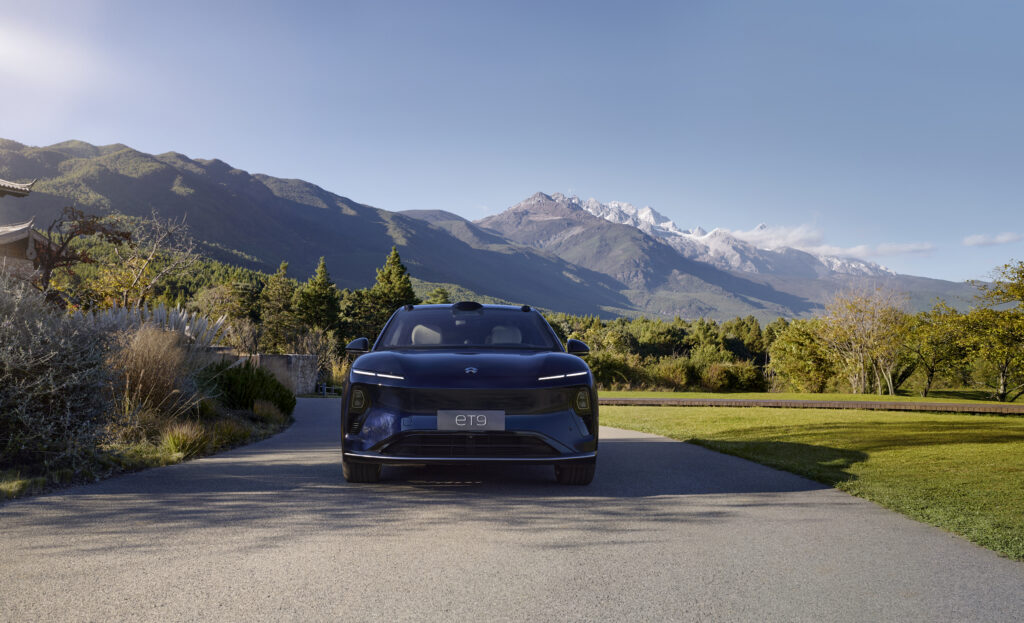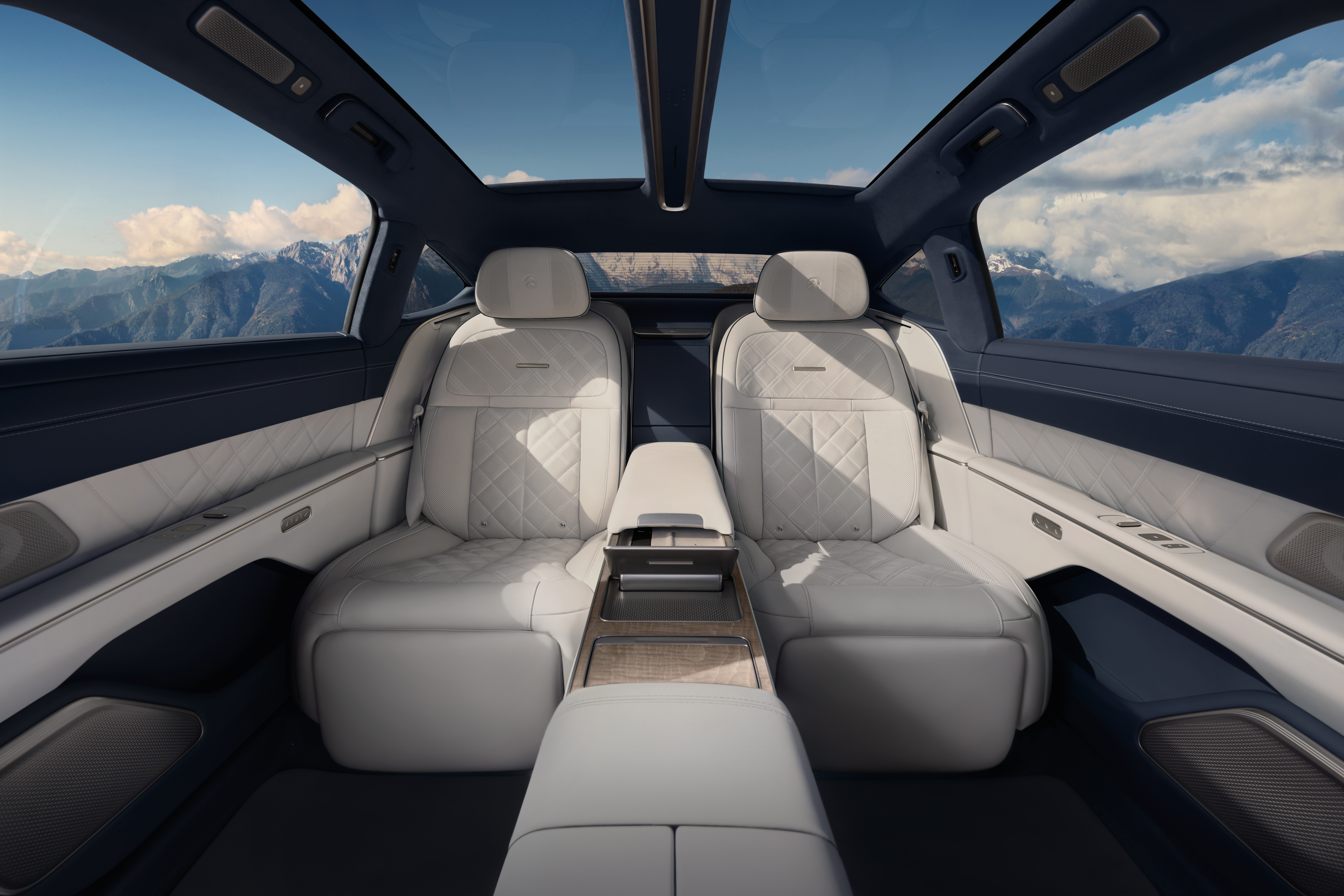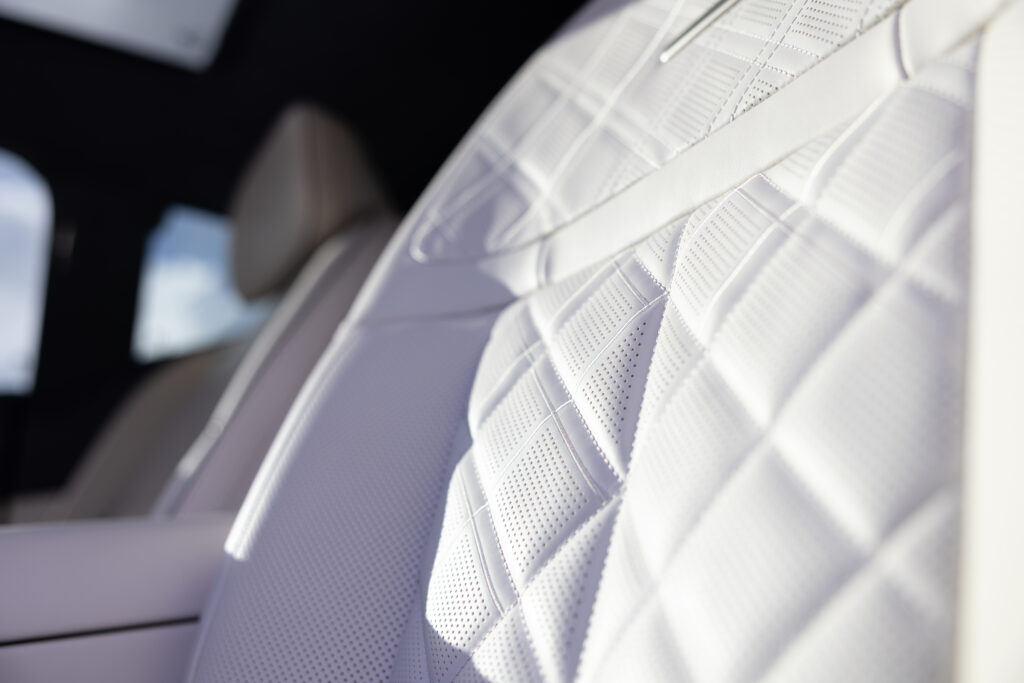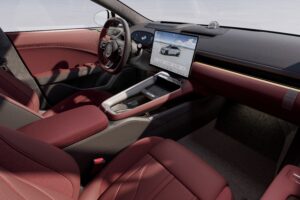Flagship ‘landjet’ targets Maybach with focus on luxury, tech, safety, autonomous driving, and silky smooth ride.

The Nio ET9 has been unveiled at the brand’s annual NIO Day event in Guangzhou revealing a fastback design packed with Maybach-rivalling tech and comfort.
A fully electric ‘landjet’ design coming in at 5.32-metres long, the ET9 represents the pinnacle of the battery-swapping expert’s 10-year journey and boasts an enviable list of standard features that, on paper at least, rival even those of a Rolls-Royce Phantom.
Strap in because there’s a lot to get through here, but we’ll start with the less glamourous elements, the kind you’d expect to find on similar flagship models.
These include floating wheel caps, that stay righted at all times, and puddle lights that extend the length of the passenger compartment offering offering a 2m2 carpet of light, a well as power doors on the front and the rear.




Equipped with height adjustable air suspension as standard, the ET9 will raise the car upon entry to a height of 688mm, a figure Nio says they’ve researched offers the most comfortable cabin entry.
In addition, the ET9 boasts an all-new paint colour dubbed ‘ceramic blue, which reportedly takes 60-hours of polishing over six layers of application to achieve its glossy look.
Nio didn’t mention, or even show, the boot space on the ET9 at the event, but did make note of the 105-litre powered frunk, something Nio is calling a world-first, that can be operated by voice or by dangling your foot in front of the car.
At the rear, an active spoiler can be deployed at the edge of the sloping roofline, which provides up to 550Nm of additional downforce to counteract the lift-inducing rear-shape.




Inside, the ET9 takes things up several notches further, with a 4-seat VIP cabin offering enclosed seats for each individual courtesy of the 2.15-metre long ‘Executive Bride’, a cabin-length centre console decked in a single piece of Sycamore wood for a unique finish in each car.
The console itself contains 20 features, including a rear screen to operate the seats, a foldout table that can swivel to either side or the centre, that also boasts a vanity mirror inside, wireless chargers front and rear, and two of the car’s 35-speakers, which we’ll come onto in moment.
Beneath the rear seats at foot-level, the console conceals a 10-litre power drawer unit for cooling to as low as -2-degrees, and warming as high as 55-degrees.
Meanwhile between the rear backrests, a second 8-litre compartment works as a safe with a concealed tray underneath for safe storage of precious valuables.




The rear seats, clad in intricately stitched Nappa leather and constructed of 14-layer foam, boast the usual heating, ventilation, and massage functions, with 16-point hot stone massage and heating that extends to the leg rests and arm rests in the doors and centre console.
Both seats, with a base cushion length of 58.2cm, can be reclined to 135-degrees and will automatically push both front seats forwards for uncompromised relaxation, made possible thanks to the steer-by-wire steering that retracts the steering wheel.
Screens are also plentiful in number, with a slim 48-inch 5k OLED screen stretching the width of the front cabin, punctuated by a 15.6-inch 3k centre screen with subtly rounded bezels, while an AR head-up display adds extra high-level information.



Twin 14.5-inch 3k HDR screens provide the entertainment in the rear and can be used alone or combined as one full-car system. They should features built-in cameras for seamless meetings on the go like those on the ET7 which we reviewed here.
Twin panoramic windows with independently operated sunshades, as well as an additional five electric sunshades around the vehicle, ensure privacy and protection from the sun as desired.

Nio is also launching the LYRA high-end sound system on the ET9, a staggering 35-speaker package with what Nio are calling an 8.2.4.8 system.
This means eight surround sound speakers, two subwoofers offering 600W of power alone, four roof-mounted speakers, and eight headrest mounted speakers.
Combined, they produce 2800W of output, and in addition to being Dolby Vision Atmos compatible, also use something called Dirac Dimensions, enabling them to turn stereo sound into hi-fi quality audio.
The speakers are also utilised to offer active road noise cancellation keeping the no doubt impressively quiet cabin even more silent on the move.
Five-layer diffused ambient lighting, fortune coin pattern metal covers on the speakers, and white and blue interior upholstery, round off a beautifully premium looking interior.




Nio is also taking the opportunity of its flagship to roll out its next-level technology package, which boasts the latest Cedar intelligent architecture which is comprised of the ever-present NOMI, the SkyOS operating system, AQUILA super-sensing system, and ADAM autonomous driving system.
Equipped with the NX9031 chip, self-made by Nio, it promises millisecond responses, milliampere control, and multiple safety redundancies, something Nio demonstrated by showing how the rear screens will immediately display the side-view camera when a passenger presses the door release button to ensure the safety of passing vehicles.
But its use is far more notable as part of the vehicle’s comprehensive safety suite, which features 31 sensing units and a triple lidar set up for visibility of around 400,000sqm. Twin lidars on the sides can see 150 metres with a vertical vision of 70-degrees and horizontal vision of 120-degrees, while the roof-mounted lidar can see up to 500-metres ahead, giving a 350-degree view around the car.
This all supports the autonomous driving capability, which is further supported by 26 billion kilometres of real user data training the Nio WorldModel platform for ever-improving autonomous ability.


The car itself sits on a 925-volt platform and boasts dual motors, a 180kW motor on the front axle, and 340kW motor on the rear, for a combined 520kW and 780Nm of torque, giving it a 0-100kph sprint of 4.3 seconds.
Fitted with a 100kW battery, it offers peak charging power of 600kW and is capable of 650km of range on the CLTC cycle, with a class-leading energy usage of 16.2kWh per 100km.
Equipped with China’s first mass-produced steer-by-wire technology on a car, as well as air suspension and 8.3-degree rear wheel steering, it has a variable steering ratio from 6:1 to 14:1, enabling parking steering requiring just 10-degrees of turn on the wheel, and can perform a U-turn in just 10.9-metres, less than a Mini.
The real head-turner is the active air suspension, which reads the road ahead for bumps and adjusts according, enabling the Nio to complete a course of staggered speed bumps while maintaining a 5-tier champagne tower on the bonnet, a feat Nio proved together with former VW boss Herbert Diess.
The active suspension not only supports a smooth ride, it can also assist in accidents, and even as part of the audio system.
When the vehicle detects an incoming crash for any side, the suspension can raise as much as 50mm in 0.7 seconds to lift the point of impact, an act proven to reduce head injuries by as much as 72 percent.
It can also sustain control of a vehicle when a tyre blowout occurs while the car is cornering up to 0.6G and can also maintain a straight trajectory with a rapid tyre blowout at speeds up to 170kph, and demonstrated by Nio CEO Li Bin himself at 160kph.
When activated as part of a 5D surround sound experience, the air suspension will move at up to 1000 times per second to enhance the physical experience of a move, or even on built-in video games on the car screen.
All 999 examples of the first limited editions sold out immediately for a price of RMB 818,000, or RMB 690,000 when equipped with the BaaS battery rental, while everyone else can pick up theirs for RMB 788,000, or RMB 660,000 with battery rental.




Blows wide open the German kerwaliti myth. NIO has made a car the has presence, yet is understated, and has real luxury, not just vulgar chinz and tinsel.
You do the best auto reviews that I have found on the internet. Thank you and all the best for 2025.
Thanks so much Dan. Much appreciated.